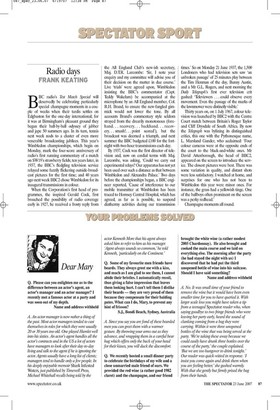Radio days
FRANK KEATING BBC radio's Test Match Special will deservedly be celebrating particularly special champagne moments in a couple of weeks when their tardis settles on Edgbaston for the one-day international; for it was at Birmingham's pleasant ground they began their ball-by-ball odyssey of jabber and jape 50 summers ago. In its turn, tennis next week nods to a cluster of even more venerable broadcasting jubilees. This year's Wimbledon championships, which begin on Monday, mark the four-score anniversary of radio's first running commentary of a match on SW19's strawberry fields; ten years later, in 1937, the BBC's fledgling television service relayed some fuzzily flickering outside-broadcast pictures for the first time; and 40 years ago next week BBC2 chose Wimbledon for its inaugural transmissions in colour.
When the Corporation's first head of programmes, the inspired Gerald Cock, first broached the possibility of radio coverage early in 1927, he received a frosty reply from the All England Club's new-ish secretary, Maj. D.T.R. Larcombe: 'Sir, I note your enquiry and my committee will advise you of their decision on the matter in due course.' Live 'trials' were agreed upon, Wimbledon insisting the BBC's commentator (Capt. Teddy Wakelam) be accompanied at the microphone by an All England member, Col. R.H. Brand, to ensure the new-fangled gimmick would not lower the tone. By all accounts Brand's commentary style seldom strayed from the drearily monotonous (forehand. . . recovery. . . backhand. . . recovery. . . smash!. . . point scored'), but the broadcast was deemed a triumph, and next summer the BBC budgeted £100 for the fortnight with two-hour transmissions each day.
By 1937, Cock was the first director of television and, now on cordial terms with Maj. Larcombe, was asking, 'Could we carry out experimental relays? Our apparatus has not yet been used over such a distance as that between Wimbledon and Alexandra Palace.' Two days before the championships began, a BBC engineer reported, 'Cause of interference to our mobile transmitter at Wimbledon has been traced to Hornsey Central Hospital, which has agreed, as far as is possible, to suspend diathermy activities during our transmission times.' So on Monday 21 June 1937, the 1,500 Londoners who had television sets saw 'an unbroken passage' of 25 minutes play between the Tim Henman of the day, Bunny Austin, and a Mr G.L. Rogers, and next morning the Daily Telegraph's first ever television crit gushed: 'Televiewers . . . could observe every movement. Even the passage of the marks of the lawnmower were distinctly visible.'
Thirty years on, on 1 July 1967, colour television was launched by BBC2 with the Centre Court match between Britain's Roger Taylor and Cliff Drysdale of South Africa. By now the Telegraph was bylining its distinguished critics, this one with the Pythonesque name, L. Marsland Gander, who acclaimed: 'Four colour cameras were at the opposite ends of the court to the black-and-white ones. Mr David Attenborough, the head of BBC2, appeared on the screen to introduce the service. The closest pictures were best. There was some variation in quality, and distant shots were less satisfactory. I watched at home, and surprises for one who has not been to Wimbledon this year were minor ones. For instance, the grass had a yellowish tinge. One of the ballboys often prominent on the screen was a perky redhead.'
Champagne moments all round.





























































 Previous page
Previous page